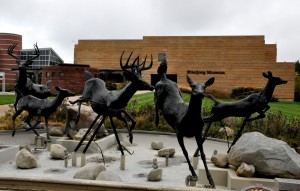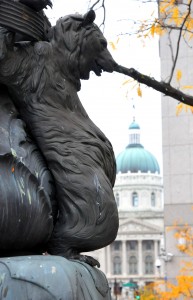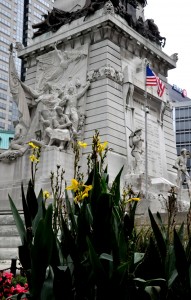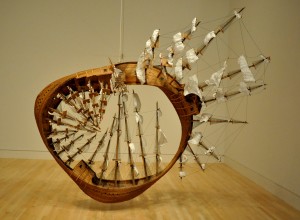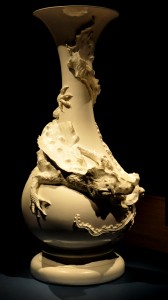As my Dear One said, “The Indianapolis Museum of Art is so good, no wonder the Colts wanted to move here.”
The city is, in fact, an amazing place for art. And it’s full of nice people and courteous drivers. Real estate is probably pretty affordable, too. Altogether a nice place to live, even if it doesn’t have any ocean front. And the coolest thing of all? The Carniceria Guanajuato on Shadeland, just down the street from our Hampton Inn. Went in to buy limes because what, after all, is a vodka-tonic without lime? The smell of this Mexican grocery store was intoxicating and I came out—with limes—to tell my Dear One that what a wonderful place it was. Went back in to get some tamales for supper—and discovered when I got back to the car that himself had gone in to explore. The tamales were fabulous; next night we were back for the tacos. Got a “margarita fresas” without alcohol, too, and it was like having a liquid strawberry sorbet with whipped cream for dessert. Go look for it: you can’t miss that coral and terracotta and ochre building with the sign that says Taqueria!
An iffy weather forecast and our desire to get started on the day led us to the Eiteljorg Museum of American Indians and Western Art and the White River Park first and the Indianapolis Museum of Art later—and a good thing, too, because if we had started at the IMA, we never would have made it anywhere else. Anyway, the Eiteljorg, I had thought, was western art and indeed it is. They even have a Harry Jackson sculpture of John Wayne as Rooster Cogburn (“The Marshall,” 1970). Now interviewing Harry for an article for “Sculpture Review” magazine was not a pleasant experience. Discovering he had been married to the magnificent painter Grace Hartigan (1922-2008) was high ick factor. Having to analyze his art in a positive and admiring way really tested my writing skills. And my BS skills. Apparently the Eiteljorg acquired the thing from the Indianapolis Museum of Art which was deaccessioning it to purchase more appropriate and worthwhile objects, a move of which I heartily approve although deaccessioning is something I normally view with extreme suspicion. Harrison Eiteljorg bought the thing from Harry, gave it to the IMA in 1973 and then the Eiteljorg Museum bought it for $30,000 or $5,000 above the auction estimate. Interesting.
Anyway, a better reason to visit the Eiteljorg is the second floor and the First Peoples’ collections. The displays are rich and diverse, the labels and didactics informative, compelling, and most of the time just plain depressing. I had just finished reading the Smithsonian anthology, American Indians/American Presidents (a gift from a former student Molly who just completed an internship at the National Museum of the American Indian in Washington DC). It is a dispassionate litany of (mostly) crimes committed over 225 years or more at the behest of the US presidents; leaves one pretty damned upset about the mixed legacy we have as “Americans.”
And those thoughts took some of the joy out of the red-brick road compass rose of Monument Circle and the towering and ornate Soldiers and Sailors Monument at its heart. It was built between 1887 and 1902 and bronze figures, weaponry, and animals encrust the white limestone fountains and obelisk. There is a list of conflicts and their dates: the Mexican War, the Civil War, and, of course the Indian Wars including such horrors and the Battle of Tippecanoe. I don’t think one can consider taking down such a thing, or fundamentally altering it. It seems, however, a chance to ask schoolchildren, citizens and visitors alike exactly why we are glorifying these “sacrifices” and why we would ask any son or daughter of this or any other nation to add another name to those already memorialized.
A young woman riding up the elevator at the parking facility with us was wearing a Colts sweatshirt. I made a comment about our purloined footballers—thank heavens she smiled—and her boyfriend said, “My grandfather worked for Mayflower—I think he was one of the drivers that moved the team out of Baltimore.”
The luminous white spaces at the top of the Indianapolis Museum of Art hold art of a recent vintage—and there was ample opportunity to bitch about the lousy quality of the labels. Why is it that the amount of gobbledygook in a label is directly proportional to the level of abstraction in the work and the recentness of its creation? Is it that curators of contemporary art are especially prone to speaking in tongues known only to themselves and their privileged peers? Then we noticed that the Herman Miller desk in the front of the Design gallery was exactly the same as the one we just saw on a recent episode of Antiques Roadshow. The young woman from the Boston area that owned it found out it was worth five to seven thousand dollars; I believe she has her grandparents to thank.
But it was on the main exhibition level that we were absolutely hooked. What other museum has that quantity and quality of both the Pont-Aven painters and the Neo-Impressionists? It was like a showdown between the gang of Paul Gauguin and the followers of Georges Seurat! We kept going and found ourselves working through the Renaissance and the small elegant rooms of the original structure, really a rabbit warren of the best kind, finding an old library filled with Elizabethan and 15th century Flemish portraits, an exhibition on the Bellini studio and the methods used to churn our nearly identical Madonnas. A kindly guard directed us down an obscure hall from whence we emerged into 19th century Americana and finally into the 20th century moderns.
As we headed toward the sculpture garden, we realized that it was heading toward six pm and nearly too dark to take pictures. Moreover, if we were going to get supper we needed to do it soon. Thank heavens for the Guanajuato. I bet some of the Colts eat there after an afternoon among Indy’s treasures.

